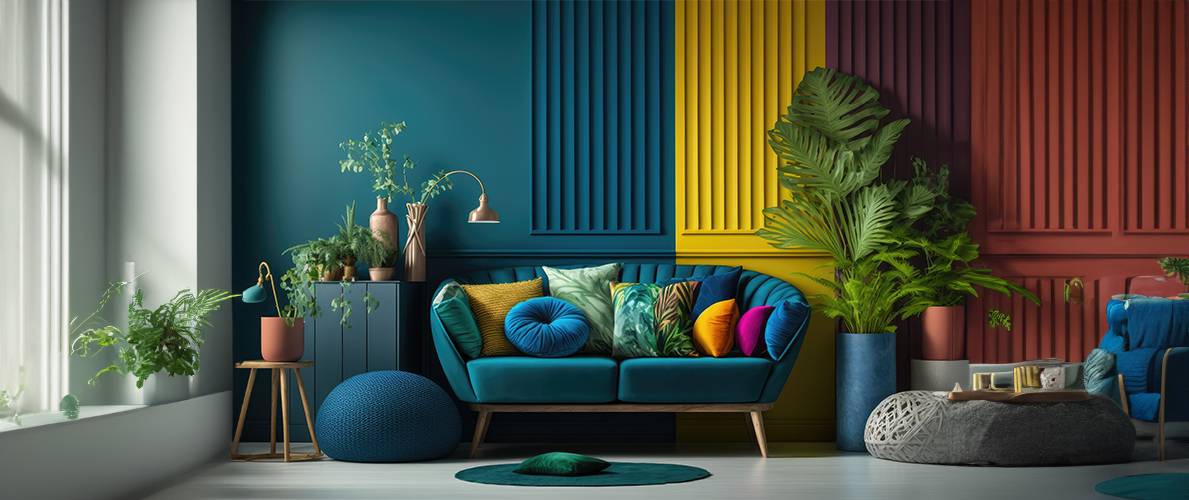Transform Your Home With Vital Concepts of Inside Layout and Aesthetics
By comprehending the impact of shade concept and the importance of texture and patterns, one can develop areas that are not only aesthetically attractive but additionally deeply personal. Achieving this stability includes even more than simple decoration; it incorporates a calculated arrangement and an eager understanding of exactly how each element connects within an area.
Understanding Shade Theory
Recognizing the principles of shade concept allows designers to produce rooms that resonate mentally with passengers while meeting functional demands. Each group plays an essential duty in establishing harmony within an area.
The emotional influence of colors is profound; warm colors such as reds and oranges stimulate power and warmth, while amazing tones like blues and environment-friendlies advertise calmness and serenity. The usage of corresponding shades improves aesthetic passion, developing striking contrasts that can boost an area's allure.
Neutral shades, on the various other hand, offer as a functional background, permitting various other layout components to beam. It is necessary to consider factors such as lighting and the room's purpose when selecting a shade scheme, as these can modify the assumption of shades throughout the day.
Eventually, a well-considered color pattern can transform a room, cultivating a feeling of comfort and style that aligns with the inhabitants' choices. Proficiency of shade theory is, for that reason, an important skill for any indoor developer aiming to create unified and welcoming atmospheres.
Accomplishing Balance in Layout
How can developers attain a sense of equilibrium in their rooms? Attaining balance in design is basic to producing harmonious insides. Developers can utilize 3 key sorts of equilibrium: in proportion, asymmetrical, and radial. Balanced equilibrium involves preparing aspects uniformly around a central factor, promoting a feeling of order and tranquility. This kind commonly features sets of furnishings or artwork, enhancing aesthetic stability.
Asymmetrical equilibrium, on the other hand, counts on differing aspects that still achieve a cohesive appearance. This method permits more vibrant and informal setups, offering passion while maintaining balance. By thoroughly choosing differing sizes, shades, and textures, developers can create a visually engaging room that feels well balanced yet energised.
Radial balance highlights a main focal factor with elements emitting exterior. This style is generally seen in circular designs, where furnishings and decor produce a natural border that draws the eye inward.
Inevitably, attaining balance needs thoughtful factor to consider of range, percentage, and the partnerships between aspects. luxury interior design. By skillfully applying these balance principles, designers can transform areas into atmospheres that really feel both cosmetically pleasing and functionally unified, boosting the total experience for occupants
Importance of Spatial Awareness

An eager feeling of spatial recognition permits developers to identify focal points within a room, directing the audience's interest to crucial functions while keeping a total feeling of unity. It additionally helps in the critical positioning of lights, which can significantly influence the perception of space and discover here mood. Additionally, understanding spatial relationships enables the designer to deal with the specific requirements of residents, making click here for more sure that each area serves its intended purpose without compromising aesthetic appeals.
Ultimately, spatial awareness is critical for making the most of the possibility of any type of interior space. By thoroughly considering the interaction between measurements, design, and function, developers can produce settings that not just fulfill functional demands but likewise evoke a feeling of comfort and appeal, enhancing the general living experience.
Incorporating Appearance and Patterns
Embracing a varied variety of appearances and patterns can substantially enhance the visual and responsive appeal of an indoor space. The critical usage of different products-- such as wood, steel, fabric, and stone-- develops depth and rate of interest, making an area feel a lot more inviting and dynamic. For circumstances, combining smooth surfaces with harsh textures can establish an equilibrium that attracts the eye and engages the senses.
When incorporating patterns, think about both range and repetition. Big a fantastic read patterns can act as prime focus, while smaller, refined designs can enhance other components without overwhelming the area. Layering patterns, such as pairing flower pillows with striped tosses, adds intricacy and a feeling of consistency if performed attentively.
It is also important to preserve a cohesive color combination, making sure that appearances and patterns collaborate rather than complete for focus. By choosing a few essential textures and patterns, you can create an unified visual that mirrors your personal style while enhancing the total atmosphere of the space. Eventually, the cautious incorporation of these components can change a mundane space into an innovative atmosphere abundant with character and heat.
Individualizing Your Area
Producing a space that mirrors your character is important to achieving an absolutely inviting setting. Customization in interior decoration allows you to instill your distinct design and rate of interests into your home, changing it from a mere sanctuary into a shelter that talks to that you are. Begin by selecting a shade palette that reverberates with your emotions-- vibrant colors can stimulate, while soft tones offer harmony.
Incorporate art work and style that show your interests, whether it be travel, nature, or abstract principles. Displaying individual collections, such as publications, photos, or keepsakes, can evoke treasured memories and create focal points within an area. Additionally, think about tailoring functional items, like upholstered furnishings, to align with your visual choices.

Conclusion
In conclusion, the change of a home with the crucial principles of interior decoration and aesthetics necessitates a detailed understanding of shade concept, equilibrium, spatial recognition, texture, and personalization. Each aspect contributes dramatically to developing an unified and functional living environment - Architecture Firm. By attentively incorporating these concepts, people can boost the visual appeal and emotional resonance of their spaces, ultimately fostering a home that reflects unique identities while supplying convenience and functionality